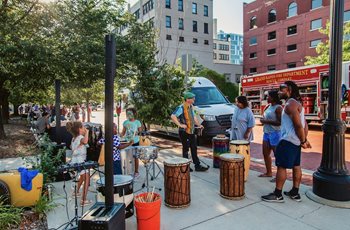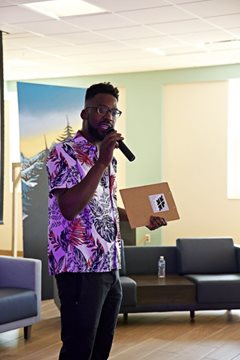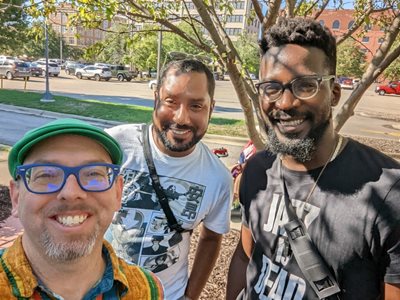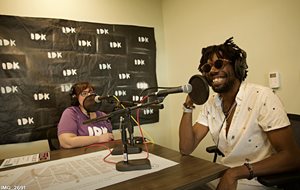Josh Dunigan pulls his blue van near a sculpture garden outside Ferguson Apartments and starts unloading. The drums come out first, arranged in a circle so residents can pick them up. Next comes a keyboard. A microphone. A sound system.
 Dunigan, an artist in residence at a Michigan CDC, Dwelling Place, wants people in the community to be able to express themselves and communicate in different ways. "Music is a language," he says. "What music does for us is allow people to be expressive of something inside of them that words don't allow, to communicate in a simple but rich way."
Dunigan, an artist in residence at a Michigan CDC, Dwelling Place, wants people in the community to be able to express themselves and communicate in different ways. "Music is a language," he says. "What music does for us is allow people to be expressive of something inside of them that words don't allow, to communicate in a simple but rich way."There are two other artists in residence at Dwelling Place – Ricardo Tavarez, a photographer who is working on a photo project at the community garden, and Brandon Copeland, a saxophone player whose notes can be heard from his practice room beneath the Dwelling Place's community engagement offices and at neighborhood gatherings. This is just one way the NeighborWorks network organization incorporates art and creativity into the community.
Arts and place
"Arts and culture are more than tools to beautify neighborhoods," says Calece Johnson, manager of Evaluation and Special Projects at NeighborWorks. "In our NeighborWorks organizations' communities, arts and culture are integral to the residents and organizations striving for equitable communities. Behind every mural or performance is the story of a community, its history, its diversity and how its people are working together toward a shared vision."
communities, arts and culture are integral to the residents and organizations striving for equitable communities. Behind every mural or performance is the story of a community, its history, its diversity and how its people are working together toward a shared vision."
 communities, arts and culture are integral to the residents and organizations striving for equitable communities. Behind every mural or performance is the story of a community, its history, its diversity and how its people are working together toward a shared vision."
communities, arts and culture are integral to the residents and organizations striving for equitable communities. Behind every mural or performance is the story of a community, its history, its diversity and how its people are working together toward a shared vision."Dwelling Place has art projects woven into the fabric of their community – not just the artists in residence, which they've worked toward for years, but mural projects, sculpture projects and more. "It's important to have people's experience, identities and culture reflected back to them in the neighborhood they live in," explains Jenn Schaub, director of Community Building and Engagement. "Our community arts programming opens doors for people to be a part of what they see on their block or even in their apartment building."
The artists in residence engage the community members ("it takes it to a new level," says Schaub); so do more traditional projects, like the murals that go on the walls of many of the properties, reflecting the community and its history. "We hope residents have a sense of ownership and connection," Schaub says. "We believe in the power of people collectively coming together, taking action and sharing stories. Our work in the arts is a tool for building connections and community."

The Artist in Residence program brings different forms of art into the neighborhood and exposes residents – like him – to new experiences. He has worked with Taverez as part of the current project in the community gardens.
 Dwelling Place is part of a cohort of NeighborWorks organizations that focuses on using and experimenting with creative community development tools. Funding from NeighborWorks allowed Copeland to become certified through the NeighborWorks Training Institute in Creative Community Development, and also funds some of the engagement activities, while grants provide stipends for the Artists in Residence. Schaub says that over time, she hopes to speak to other NeighborWorks network organizations engaged in similar practices. "I want to learn what their experiences with artists in residence are like – talk about ways to best sustain the program and keep it going," she says.
Dwelling Place is part of a cohort of NeighborWorks organizations that focuses on using and experimenting with creative community development tools. Funding from NeighborWorks allowed Copeland to become certified through the NeighborWorks Training Institute in Creative Community Development, and also funds some of the engagement activities, while grants provide stipends for the Artists in Residence. Schaub says that over time, she hopes to speak to other NeighborWorks network organizations engaged in similar practices. "I want to learn what their experiences with artists in residence are like – talk about ways to best sustain the program and keep it going," she says.
